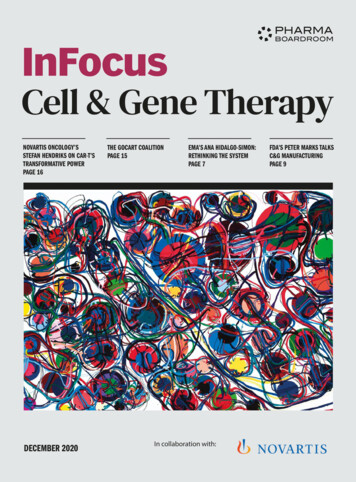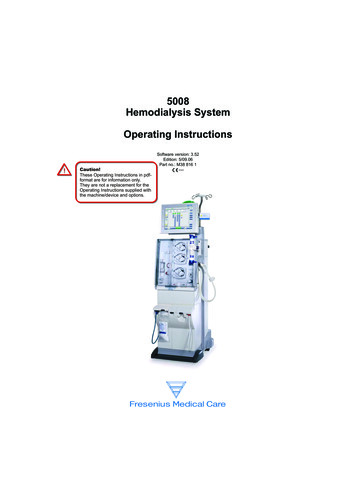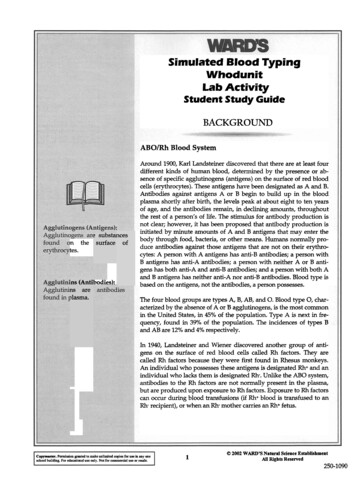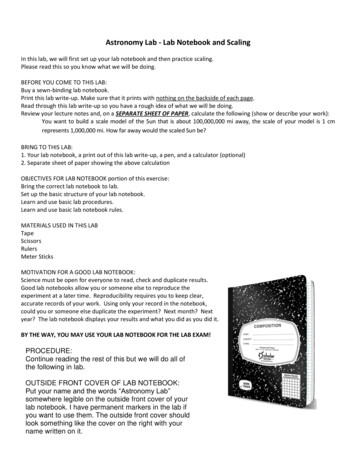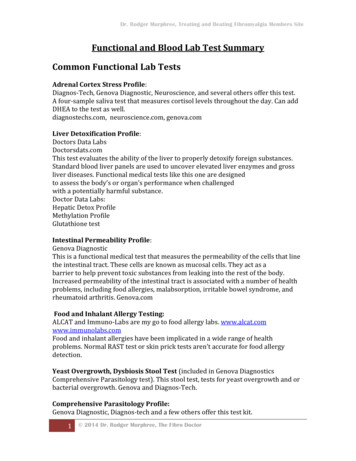
Transcription
Dr. Rodger Murphree, Treating and Beating Fibromyalgia Members SiteFunctional and Blood Lab Test SummaryCommon Functional Lab TestsAdrenal Cortex Stress Profile:Diagnos-Tech, Genova Diagnostic, Neuroscience, and several others offer this test.A four-sample saliva test that measures cortisol levels throughout the day. Can addDHEA to the test as well.diagnostechs.com, neuroscience.com, genova.comLiver Detoxification Profile:Doctors Data LabsDoctorsdats.comThis test evaluates the ability of the liver to properly detoxify foreign substances.Standard blood liver panels are used to uncover elevated liver enzymes and grossliver diseases. Functional medical tests like this one are designedto assess the body’s or organ’s performance when challengedwith a potentially harmful substance.Doctor Data Labs:Hepatic Detox ProfileMethylation ProfileGlutathione testIntestinal Permeability Profile:Genova DiagnosticThis is a functional medical test that measures the permeability of the cells that linethe intestinal tract. These cells are known as mucosal cells. They act as abarrier to help prevent toxic substances from leaking into the rest of the body.Increased permeability of the intestinal tract is associated with a number of healthproblems, including food allergies, malabsorption, irritable bowel syndrome, andrheumatoid arthritis. Genova.comFood and Inhalant Allergy Testing:ALCAT and Immuno-Labs are my go to food allergy labs. www.alcat.comwww.immunolabs.comFood and inhalant allergies have been implicated in a wide range of healthproblems. Normal RAST test or skin prick tests aren’t accurate for food allergydetection.Yeast Overgrowth, Dysbiosis Stool Test (included in Genova DiagnosticsComprehensive Parasitology test). This stool test, tests for yeast overgrowth and orbacterial overgrowth. Genova and Diagnos-Tech.Comprehensive Parasitology Profile:Genova Diagnostic, Diagnos-tech and a few others offer this test kit.1 2014 Dr. Rodger Murphree, The Fibro Doctor
This profile checks for parasites, bacteria (good and bad) and yeast overgrowthinhabiting the intestinal tract-the test requires a 1-3 stool samples.In a study of outpatients at the Gastroenterology Clinic in Elmhurst, New York, a74-percent incidence of parasites was found. Genova Diagnosticsin Asheville, North Carolina, is arguably the best stool-testing lab in the world.They report that 30 percent of all examined specimens are positive for parasites.Hair Elemental Analysis:Genova Diagnostic, Doctors Data and others.This test is not an accurate test for mineral levels and shouldn’t be used to measuremineral stores. Still, an inexpensive screening like a hair analysis is an idealway to uncover any potential heavy metal toxicity. Heavy metals include cadmium(in smokers), aluminum, lead, mercury, tin, silver, and arsenic. Heavy metal toxicitycan present a host of unwanted symptoms.Blood LabsAlanine Aminotransferase (ALT):10-26 U/LAlanine transaminase (ALT) is an enzyme found in the highest amounts in the liver.Injury to the liver results in release of the substance into the blood.Increased levels of ALT often mean that liver disease is present. Liver disease iseven more likely when levels of other liver blood tests are also increased.Increased in:CirrhosisLiver necrosisHepatitisHemochromatosisLack of blood flow to the liver (liver ischemia)Liver tumor or cancerMedications that are toxic to the liverMononucleosisPancreatitisIf between 27 and 150 with elevated triglycerides, suspect fatty liver (steatosis).This is usually due to insulin resistance, diabetes or alcohol abuse. If elevated ALT istwice that of AST, then alcohol induced liver disease should be suspected.ALT levels above 200 UL suggest hepatitis, especially when WBC are depressed orelevated.Decreased in:Vitamin B6 anemiaElevated triglycerides, along with low ALT, suggests fatty liver syndrome. ElevatedALT with normal triglyceride levels indicates possible vitamin B6 deficiency.2 2014 Dr. Rodger Murphree, The Fibro Doctor
Albumin4.0-5.0 G/dlAlbumin is a protein made by the liver. A serum albumin test measures the amountof this protein in the clear liquid portion of the blood. Albumin helps move manysmall molecules through the blood, including bilirubin, calcium, progesterone, andmedications. It plays an important role in keeping the fluid from the blood fromleaking out into the tissues. Decreased albumin levels are always a sign of eithersever liver disease or immune dysfunction. When albumin is decreased andglobulins are elevated, suspect liver disease.Increased in: Dehydration High protein dietHaving a tourniquet on for a long time when giving a blood sampleDecreased in:Liver/biliary dysfunctionCancerProtein deficiencyAlkaline Phosphatase70-90 U/LAlkaline phosphatase (ALP) is a protein found in all body tissues. Tissues withparticularly high amounts of ALP include the liver, bile ducts, and bone.Many drugs affect the level of alkaline phosphatase in the blood. Drugs that mayaffect the ALP level may include:AllopurinolAntibioticsBirth control pillsCertain diabetic medsChlorpromazineCortisoneMale hormonesMethyldopaNarcotic pain medicinesNon-steroidal anti-inflammatory drugs (NSAIDs)PropranololTranquilizersTricyclic antidepressantsIncreased in:Liver cancerCirrhosisThird trimesterImpaired bile flowPaget’s bone diseaseHealing bone fracture3 2014 Dr. Rodger Murphree, The Fibro Doctor
Decreased in:Biliary obstructionZinc deficiencyVitamin C deficiencyAntinuclear Antibodies (ANA)This is a blood test that measures autoimmune reactions. A positive finding mayindicate rheumatoid arthritis, scleroderma, or lupus (if accompanied by glucoronicacid) in the liver.ANA shows up on indirect immunofluorescence as fluorescent patterns in cells thatare fixed to a slide that is evaluated under a microscope. Different patterns havebeen associated with a variety of autoimmune disorders, although overlap mayoccur. Some of the more common patterns include: Homogenous (diffuse) - associated with SLE and mixed connective tissue disease Speckled - associated with SLE, Sjogren syndrome, scleroderma, polymyositis,rheumatoid arthritis, and mixed connective tissue disease Nucleolar - associated with scleroderma and polymyositis Centromere pattern (peripheral) - associated with scleroderma and CREST(Calcinosis, Raynaud's syndrome, Esophogeal dysmotility, Sclerodactyly,Telangiectasia)An example of a positive result might be: "Positive at 1:320 dilution with ahomogenous pattern."A positive ANA test result may suggest an autoimmune disease, but further specifictesting is required to assist in making a final diagnosis. ANA test results can bepositive in people without any known autoimmune disease. While this is notcommon, the frequency of a false positive ANA result increases as people get older.Also, ANA may become positive before signs and symptoms of an autoimmunedisease develop, so it may take time to tell the meaning of a positive ANA in a personwho does not have symptoms. Most positive ANA results don't have significance, sophysicians should reassure their patients but should also still be vigilant fordevelopment of signs and symptoms that might suggest an autoimmune disease.About 95% of those with SLE have a positive ANA test result. If someone also hassymptoms of SLE, such as arthritis, a rash, and autoimmune thrombocytopenia, thenshe probably has SLE. In cases such as these, a positive ANA result can be useful tosupport SLE diagnosis. Two subset tests for specific types of autoantibodies, such asanti-dsDNA and anti-SM, may be ordered (often as an ENA panel) to help confirmthat the condition is SLE.A positive ANA can also mean that the person has drug-induced lupus. Thiscondition is associated with the development of autoantibodies to histones, whichare water-soluble proteins rich in the amino acids lysine and arginine. An anti4 2014 Dr. Rodger Murphree, The Fibro Doctor
histone test (order anti-histone antibodies test) may be ordered to support thediagnosis of drug-induced lupus.Other conditions in which a positive ANA test result may be seen include: Sjögren syndrome: Between 40% and 70% of those with this condition has apositive ANA test result. While this finding supports the diagnosis, a negative resultdoes not rule it out. The doctor may want to test for two subsets of ANA: Anti-SS-A(Ro) and Anti-SS-B (La). About 90% or more of people with Sjögren syndrome haveautoantibodies to SSA. Scleroderma (systemic sclerosis): About 60% to 90% of those with sclerodermahave a positive ANA finding. In people who may have this condition, ANA subsettests can help distinguished two forms of the disease, limited versus diffuse. Thediffuse form is more severe. Limited disease is most closely associated with theanticentromere pattern of ANA staining (and the anticentromere test), while thediffuse form is associated with autoantibodies to the anti–Scl-70.A positive result on the ANA also may show up in people with Raynaud's disease,rheumatoid arthritis, dermatomyositis or polymyositis, mixed connective tissuedisease, and other autoimmune conditions.AST (aspartate aminotransferase)10-26 U/LSerum glutamic-oxaloacetic transaminase; SGOT is an enzyme found in highamounts in liver, heart, and muscle cells. It is also found in lesser amounts in othertissues.Increased AST levels are usually a sign of liver disease. Liver disease is even morelikely if other liver-related blood tests are abnormal.AST levels may rise during pregnancy and after exercise.Increased in:CirrhosisDeath of liver tissueHeart attackHemochromatosisHepatitisLack of blood flow to the liver (liver ischemia)Liver cancer or tumorMedicines that are toxic to the liverMononucleosisMuscle disease or traumaPancreatitisAST levels may also increase after:5 2014 Dr. Rodger Murphree, The Fibro Doctor
BurnsHeart proceduresSeizureSurgeryIf between 27 and 150 with elevated triglycerides, suspect fatty liver (steatosis).This is usually due to insulin resistance, diabetes or alcohol abuse. If elevated ALT istwice that of AST, then alcohol induced liver disease should be suspected.AST levels above 200 UL suggest hepatitis, especially when WBC are depressed orelevated.Decreased in:B6 deficiencyRenal diseaseElevated triglycerides, along with low AST, suggests fatty liver. Elevated AST withnormal triglyceride levels indicates possible vitamin B6 deficiency.Basophils0-1%Increased in:Numerous pathologiesBilirubin.2-1.2 mg/dlBilirubin is the main bile pigment. Free bilirubin isreleased into the blood when red blood cells (RBCs) are brokendown by the spleen, liver kupfer cells, and the bone marrow. In the liver, the indirectbilirubin is combined with glucoronic acid to form a water-soluble compound, director conjugated bilirubin, which is secreted in the bile.Bilirubin is classified as:Total bilirubin- a combination of direct and indirect bilirubinDirect bilirubin-post hepatic, water-soluble (conjugated)Indirect bilirubin-pre-hepatic, water-insoluble (unconjugated)Increased Conjugated BilirubinGallstones (biliary obstruction)Liver metastasisExtra hepatic duct obstructionIncreased Unconjugated BilirubinGilbert syndrome (congenital enzyme deficiency which prevents conjugation ofbilirubin)HepatitisCirrhosisHemolytic anemia6 2014 Dr. Rodger Murphree, The Fibro Doctor
Decreased levels-NABlood Urea Nitrogen12-18 mg/dlThis blood test measures urea. Urea is the end product of protein metabolism andis formed in the liver. It is excreted by the kidneys.Increased in:Kidney damage or urinary tract obstruction.Chronic renal dysfunctionRenal hypertensionDiuretic medicationDehydrationCirrhosisBPHUrinary obstructionIn renal disease should see elevated serum creatinine and phosphorous.Decreased in:Liver failure or pregnancyLiver failureProtein malnutritionCeliac diseaseIn liver disease would possibly see elevated ALT, AST and or LDH. If due tomalnutrition cholesterol levels would be low or low normalBUN/Creatinine Ratio6-25 (optimal is 10-16)Both BUN and creatinine are filtered by the kidney and excreted in urine. For thisreason, BUN and creatinine are used together to measure kidney function.If kidney function begins to decline, BUN and creatinine rise. A normal creatininedepends on muscle mass and age.Increased in:Congestive heart failureRenal diseaseDehydrationHypotensionShockIntestinal bleedingDecreased in:MalnutritionLow protein dietsC-Reactive Protein (Hs-CRP)According to the American Heart Association:7 2014 Dr. Rodger Murphree, The Fibro Doctor
Low risk of developing cardiovascular disease if your hs-CRP level is lower than1.0mg/LAverage risk of developing cardiovascular disease if your levels are between 1.0 and3.0 mg/LHigh risk for cardiovascular disease if your hs-CRP level is higher than 3.0 mg/LC-reactive protein is a substance present in tissue destruction and inflammation.Produced primarily in the liver during acute inflammatory process. It rises rapidly,but non-specifically in response to injury and inflammation. More sensitive than ESRor sed rate.Elevated levels above 3, are associated with an increased the risk of heart and orstroke. Physicians Health Study, a clinical trial involving 18,000 apparently healthydoctors, found that elevated levels of CRP were associated with a threefold increasein the risk of heart attack.Women with the highest CRP levels were more than four times as likely to have diedfrom coronary disease, or to have suffered a nonfatal heart attack or strokecompared to those with the lowest levels.Increased in:Myocardial infarction (heart disease).Viral or bacterial infectionCoronary artery inflammation/atherosclerosisRheumatoid arthritisCalcium9.0-10.0 mg/dLCalcium is the most common mineral in the body and one of the most important.The body needs it to build and fix bones and teeth, help nerves work, make musclessqueeze together, help blood clot, and help the heart to work. Almost all of thecalcium in the body is stored in bone. The rest is found in the blood.Normally the level of calcium in the blood is carefully controlled. When bloodcalcium levels get low (hypocalcaemia), the bones release calcium to bring it back toa good blood level. When blood calcium levels get high (hypercalcemia), the extracalcium is stored in the bones or passed out of the body in urine and stool.Increased in:Hyperparathyroidism (repeat serum calcium and if elevated again, perform PTH toconfirm)CancerIncreased vitamin D levelsSarcoidosisPlease know calcium shouldn't be elevated. When it is repeat the test and if after 3times it is elevated then do a PTH test.8 2014 Dr. Rodger Murphree, The Fibro Doctor
I've caught numerous patients, (referred them for benign parathyroid tumorremoval) over the years that had gone years with high normal or even slightlyelevated levels but had never been worked up or referred for a scan. My resourcefor all things parathyroid is Dr. Norman's site www.parathyroid.comFrom parathyroid.comAdults do not have persistent calcium levels above 10.1.Many people (about 20% of all patients with hyperparathyroidism) will haveparathyroid disease when they have high calcium and NORMAL PTH levelsHigh calcium and ANY PTH LEVEL that is not very low means you havehyperparathyroidism.Decreased in:Parathyroid hypo functionDigestive dysfunction-hypochlorhydriaVitamin D deficiencyProtein malnutritionOsteoporosisCholesterol150-200 mg/dLIncreased in:HypothyroidismInsulin resistance/diabetesNumerous pathologiesDecreased in:Statin useMalnutritionLow cholesterol levels, those below 150 are associated with increased death from allcauses. Men with low cholesterol levels have an increased risk of depression.HDL50-60 mg/dLDecreased in:Insulin resistanceInflammationLDL 100 mg/dLIncreased in:Insulin resistanceTriglycerides75-100 mg/dL9 2014 Dr. Rodger Murphree, The Fibro Doctor
Increased in:Non-fasting blood drawsInsulin resistance/diabetesHypothyroidismIf triglycerides are elevated above total cholesterol levels, the insulin resistanceshould be suspected.Decreased in:Malnutrition or malabsorptionHyperthyroidismComplete Blood Count (CBC):The CBC test usually includes a red blood cell (RBC) count, a white blood cell (WBC)count, hemoglobin, hematocrit, indices mean corpuscular volume.Chloride100-106 mmol/LChloride is a type of electrolyte. It works with other electrolytes such as potassium,sodium, and carbon dioxide (CO2) to help keep the proper balance of body fluidsand maintain the body's acid-base balance.Drugs that may increase serum chloride measurements include: Acetazolamide Ammonium chloride Androgens Cortisone Estrogen Guanethidine Methyldopa Non-steroidal anti-inflammatory drugs (NSAIDs)Drugs that may lower serum chloride measurements include: Aldosterone Bicarbonate-containing compounds Loop diuretics Thiazide diuretics TriamtereneIncreased in:DehydrationRenal dysfunctionDecreased in:HypochlorhydriaCO/210 2014 Dr. Rodger Murphree, The Fibro Doctor
21-33 mmol/L (optimal 26-31)In the body, most of the CO2 is in the form of a substance called bicarbonate(HCO3-). Therefore, the CO2 blood test is really a measure of your blood bicarbonatelevel. The CO2 test is most often done as part of an electrolyte or basic metabolicpanel. Changes in your CO2 level may suggest that you are losing or retaining fluid,which causes an imbalance in your body's electrolytes. CO2 levels in the blood areinfluenced by kidney and lung function. The kidneys are mainly responsible formaintaining the normal bicarbonate levels.Increased in:Metabolic alkalosisVomitingDecreased in:B1 deficiencyDiabetesMetabolic acidosisCreatinine0.7-1.1Creatinine is a waste product usually eliminated by the kidneys.Increased in:Possible kidney diseaseUrinary obstructionBPHSuspect renal disease if creatinine, BUN, and phosphorous are all elevated. Indehydration HCT, Hemoglobin, and RBCs are usually slightly elevated.Decreased in:Muscular dystrophyGeriatric patientsChildrenMuscle wasting diseasesCreatinine ClearanceThe creatinine clearance test compares the level of creatinine in urine with thecreatinine level in the blood. (Creatinine is a breakdown product of creatine, whichis an important part of muscle.) The test helps provide information on kidneyfunction.Abnormal results (lower than normal creatinine clearance) may indicate:Acute tubular necrosisBladder outlet obstructionCongestive heart failureDehydrationEnd-stage kidney diseaseGlomerulonephritis11 2014 Dr. Rodger Murphree, The Fibro Doctor
Kidney failureRenal ischemia (too little blood flow to the kidneys)Renal outflow obstruction (usually must affect both kidneys to reduce the creatinineclearance)ShockEosinophils0-3%Increased in:Parasitic infectionsAllergiesNumerous pathologiesErythrocyte Sedimentation Rate (ESR)Adults (Westergren method):Men under 50 years old: less than 15 mm/hrMen over 50 years old: less than 20 mm/hrWomen under 50 years old: less than 20 mm/hrWomen over 50 years old: less than 30 mm/hrChildren (Westergren method):Newborn: 0 to 2 mm/hrNewborn to puberty: 3 to 13 mm/hrThis test is used to detect inflammatory conditions. It is relatively nonspecific andis used as a screening tool. If levels are abnormal, further testing might be needed.Increased in heavy metal poisoning, all collagen diseases (autoimmune arthritis),some cancers, gout,infections, and other inflammatory diseases. May be decreased in sickle-cell anemiaand congestive heart failure.FerritinMale: 12-300 ng/mLFemale: 12-150 ng/mLOptimal is above 50Ferritin is a protein found inside cells that stores iron so your body can use it later.A ferritin test indirectly measures the amount of iron in your blood.The amount of ferritin in your blood (serum ferritin level) is directly related to theamount of iron stored in your body. Ideal levels are above 50.Increased in:Iron overload-hemochromatosisInflammatory diseaseHIVHepatitisDecreased in:12 2014 Dr. Rodger Murphree, The Fibro Doctor
Iron deficiency anemiaFibrinogen200 - 400 mg/dLFibrinogen is formed in the liver. In the presence ofthrombin, it is converted to fibrin as part of the clotting mechanism.Increased in:Kidney diseaseHigh levels of fibrinogen predispose a person to coronary and cerebral arterydisease, even when other known risk factors such as cholesterol are low. Fibrinogenelevation in cigarette smokers, for example, has been identified as a primarymechanism causing heart disease and stroke. Cigarette smoking increasescardiovascular disease risk, and it also raises fibrinogen levels in the blood.Decreased in:Liver diseaseGamma-glutamyl transpeptidase (GGT)10-26 U/LGamma-glutamyl transpeptidase (GGT) is a test to measure the amount of theenzyme GGT in the blood. This test is used to detect diseases of the liver or bileducts. It is also done with other tests (such as the ALT, ALP, and bilirubin tests) totell the difference between liver or bile duct disorders and bone disease.It may also be done to screen for or monitor alcohol abuse.Drugs that can increase GGT levels include:AlcoholPhenytoinPhenobarbitalDrugs that can decrease GGT levels include:Birth control pillsClofibrateIncreased in:Biliary obstructionAlcoholismBile duct and or gall bladder inflammationPancreatitisElevated GGTP below 150 with elevated triglycerides suspect fatty liver.If WBCs are also elevated then suspect hepatitis.If AST level is twice that of ALT, then suspect alcohol cirrhosis.Decreased in:13 2014 Dr. Rodger Murphree, The Fibro Doctor
Vitamin B6 deficiency below 10Globulin2.4-2.8 G/100mlGlobulin is a generic term used to describe a set of sixty proteins including theantibodies or gamma globulins and protein-carbohydrate compounds known asglycoprotein. There are four basic groups of globulin proteins known as the alpha-1,alpha-2, beta and gamma proteins. These are used to help transport proteinsthrough the lipoproteins and assisting the blood in clotting. They also act as plasmacells, which indicate whether there is an antibody deficiency in the blood stream.The liver produces much of the alpha and beta globulins used for this purpose.The level of these proteins is measured against the levels of albumin, the othermajor type of protein in the bloodstream. A specific ratio must be met in order tomaintain healthy circulatory function. Ratios of globulin compared to albumin canbe low or high, and each presents its own dangers.Increased in:HypochlorhydriaLiver dysfunction/hepatic infectionsNeoplasmDecreased in:Digestive disordersSuspect hypochlorhydria when globulin levels are out of range.Glomerular Filtration Rate (eGFR)Glomerular filtration rate (GFR) is a test used to check how well the kidneys areworking. Specifically, it estimates how much blood passes through the tiny filters inthe kidneys, called glomeruli, each minute.Levels below 60 mL/min/1.73 m2 for 3 or more months are a sign of chronic kidneydisease. A GFR result below 15 mL/min/1.73 m2 is a sign of kidney failure andrequires immediate medical attention.Glucose85-100 mg/dLGlucose (blood sugar) can be measured by either ablood or a urine test. This test is usually conducted after a periodof fasting, (MAKE SURE patient was fasting) since blood levels are naturally affectedby eating.Increased in:DiabetesCushing’s disease.14 2014 Dr. Rodger Murphree, The Fibro Doctor
Elevated glucose with elevated triglycerides (especially if triglycerides or equal to ormore than total cholesterol), uric acid, total cholesterol, LDL, and depressed HDLsignals insulin resistance.Decreased in:HypoglycemiaAddison’s diseaseIn insulin resistance you’ll often see elevated triglyceride levels that are equal to, orgreater than, total cholesterol, depressed HDL, and elevated LDL levels. In liverdisease check for elevated ALT, AST, and depressed albumin levels.HDL50-60 mg/dLDecreased in:Insulin resistanceInflammationHemoglobin:Normal range is female: 12–15 g./dl.; male: 13–16 g./dl.Hemoglobin is the oxygen-carrying portion ofRBCs.Increased in polycythemia, emphysema, asthma and dehydration.Decreased in iron anemia, internal bleeding and late pregnancy.Hematocrit:Females 37-44 Males 40-48This is a measure of the volume of settled RBCsper 100 ml. of blood.Increased in polycythemia, emphysema, asthma and dehydration.Decreased in iron anemia, internal bleeding and late pregnancy.Hemoglobin A1cAn HbA1c of 5.6% or less is normal.The following are the results when the HbA1c is being used to diagnose diabetes: Normal: Less than 5.7% Pre-diabetes: 5.7% to 6.4% Diabetes: 6.5% or higherHbA1c is a lab test that shows the average level of blood sugar (glucose) over theprevious 3 months.Increased in:DiabetesDecreased in:15 2014 Dr. Rodger Murphree, The Fibro Doctor
Chronic blood lossHemolytic anemiaHomocysteineHomocysteine is a building block for the productionof proteins in the body. However, elevated levels of itare associated with premature vascular disease. Studies have shown that increasedhomocysteine levels can dramatically increase your risk of heart disease, stroke, andperipheral vascular disease, and clotting disorders. A healthy homocysteine level isless than 7 and ideally less than 6.5.Iron85-130 ug/dLIncreased in:HemochromatosisHepatic dysfunctionDecreased in:Chronic blood lossIron deficiency anemiaMensesCancerHepatic dysfunctionCrohn’s diseaseLactic Acid Dehydrogenase LDH140-180 U/LIncreased in:36-55 hours after myocardial infarctionLiver diseaseTissues damage/breakdown-liver, heart, skeletal muscle, adrenal, lung, kidney,pancreas, and blood cellsMegoblastic and hemolytic anemiasSickle cell anemiaMalignant neoplasmsDecreased in:Reactive hypoglycemiaLDL 100 mg/dLIncreased in:Insulin resistanceMagnesium2.0-2.5 mg/dL16 2014 Dr. Rodger Murphree, The Fibro Doctor
Increased in:HypothyroidAntacids with magnesiumAddison’s diseaseRenal impairmentSevere diabetic acidosisDecreased in:MalabsorptionNumerous pathologiesMagnesium intake deficiencyMCV85-92 cu micronsMCV indicates the volume in cubic microns occupied by an average single red bloodcell.A MCV increase along with an increase or decrease in the MCH is a sign of B12, B6,and or folic acid anemia.MCV is calculated by dividing the hematocrit result by the RBC count.If this pattern shows up then good idea to test for elevated homocysteine levels.Increased in:Macrocytic anemia (B12, folic acid deficiency)DehydrationDecreased in:Microcytic anemia (iron anemia)Internal bleedingIntestinal parasitesDepressed levels MCV, MCH, and or MCHC are typically found with microcyticanemia. In iron deficiencies ferritin will be depressed and transferrin will beelevated.MCH27-32Mean Corpuscular Hemoglobin is a test for the average weight of hemoglobin that ispresent inside a red blood cell. The main responsibility of hemoglobin is to carryoxygen to the blood. It is composed of a group of amino acids that contain ironatoms, which gives the red color to hemoglobin. MCH, MCV and MCHC are threemain red blood cell indices that help in measuring the average size and hemoglobincomposition of the red blood cells.Increased MCH:Macrocytic iron deficiency (B12/Folic acid)dehydration.17 2014 Dr. Rodger Murphree, The Fibro Doctor
A high MCH results in too much hemoglobin present, which causes insufficientsupply of oxygen to the blood.Decreased MCH:Microcytic anemia (iron)Internal bleedingToxic effects of heavy metal poisoning, lead, aluminum, etc.Vitamin B6 anemiaMCHC indicates the hemoglobin concentration per unit volume (100ml) of packedcells.Increased in:Macrocytic anemia (B12/folic acid)DehydrationDeceased in:Vitamin B6 anemiaInternal bleedingHeavy metal toxicityMonocytes are active in chronic infections and Hodgkin’s disease. In inflammatoryreactions neutrophils are prominent for about 3 days then they break up and themonocytes remain active (phagocytic). Monocytes are often increased during therecovery phase of an infection.Increased in:Viral infections (mononucleosis)Phosphorous3.5-4.0 mg/dLPhosphorus is a mineral that makes up 1% of a person's total body weight. It ispresent in every cell of the body and plays a vital role in ATP function. Most of thephosphorus in the body is found in the bones and teeth. Parathyroid hormone (PTH)and the kidneys are important in regulating serum phosphorous levels. PTH ismostly responsible for increased serum calcium and decreased phosphorous levels.Increased in:Parathyroid hypo functionAcute and chronic renal dysfunctionSarcoidosisDecreased in:Parathyroid hyperfunctionDigestive disturbances-hypochlorhydriaVitamin D deficiencyPlatelet count18 2014 Dr. Rodger Murphree, The Fibro Doctor
Blood platelets strengthen the resistance of thevessel walls against trauma and are the initial factor in coagulation(clotting). Increased levels are from faulty stem cells in the bone marrow that maketoo many platelets. What causes this to happen usually isn't known. When thisprocess occurs without other blood cell disorders, it's called essentialthrombocythemia.Increased in:TraumaInflammatory arthritis including rheumatoidArteriosclerosisAnemiaBlood lossPolycythemia.Decrease
3 2014 Dr. Rodger Murphree , The Fibro Doctor Albumin 4.0-5.0 G/dl Albumin is a protein made by the liver. A serum albumin test measures the amount of this protein .
